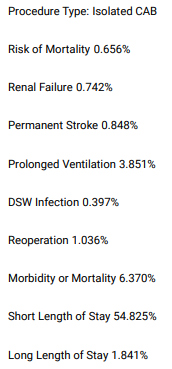Poll: Strategy for Conduit Choice during Coronary Artery Bypass Grafting
A 54-year-old woman with hypertension, hyperlipidemia, Type 2 diabetes mellitus controlled with insulin (Hgb A1C 9%), and Class 3 obesity (height 5'1", weight 211 lbs., BMI 40 kg/m2) was evaluated in the Emergency Department with unstable angina. Left heart catheterization showed significant (60%) left main disease, as well as 70% proximal left anterior descending (LAD) and 70% proximal right coronary artery stenoses. Surface echo showed normal ejection fraction (EF 65%) and no significant valvular disease. She has generous LAD, obtuse marginal (OM), and posterior descending artery (PDA) targets for coronary artery bypass grafting (CABG). Vein mapping and radial artery studies show adequate conduit. The Society of Thoracic Surgeons (STS) risk scores for mortality and major morbidity are listed below:

Clinical Topics: Cardiac Surgery, Dyslipidemia, Invasive Cardiovascular Angiography and Intervention, Prevention, Valvular Heart Disease, Atherosclerotic Disease (CAD/PAD), Cardiac Surgery and VHD, Interventions and Coronary Artery Disease, Interventions and Structural Heart Disease, Hypertension
Keywords: Middle Aged, Glycated Hemoglobin A, Radial Artery, Insulin, Body Mass Index, Diabetes Mellitus, Type 2, Hyperlipidemias, Coronary Artery Disease, Stroke Volume, Coronary Artery Bypass, Angina, Unstable, Insulin, Regular, Human, Morbidity, Hypertension, Cardiac Catheterization, Obesity, Coronary Stenosis, Emergency Service, Hospital, Surgeons, Heart Valve Diseases, Risk Factors
< Back to Listings
